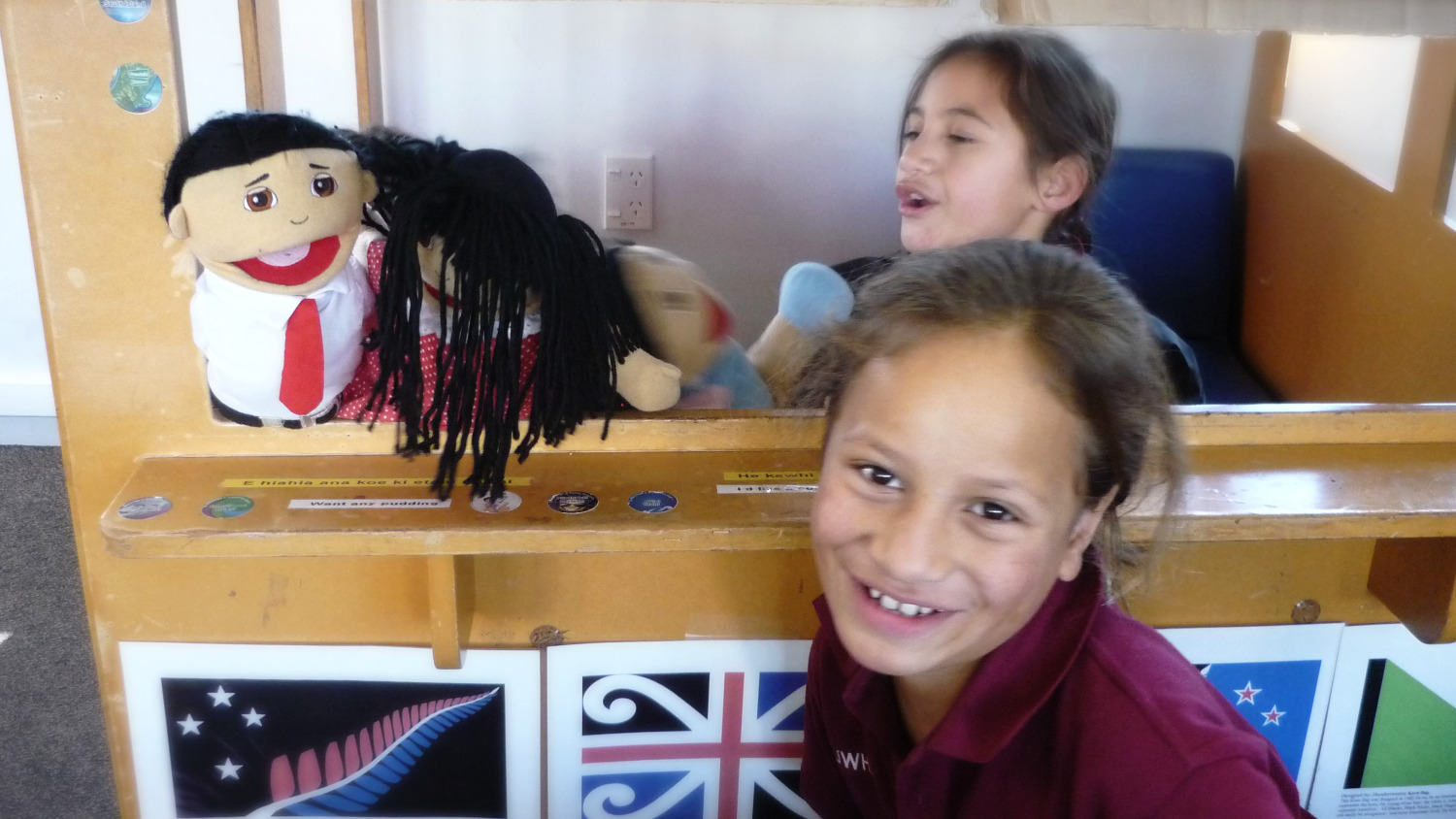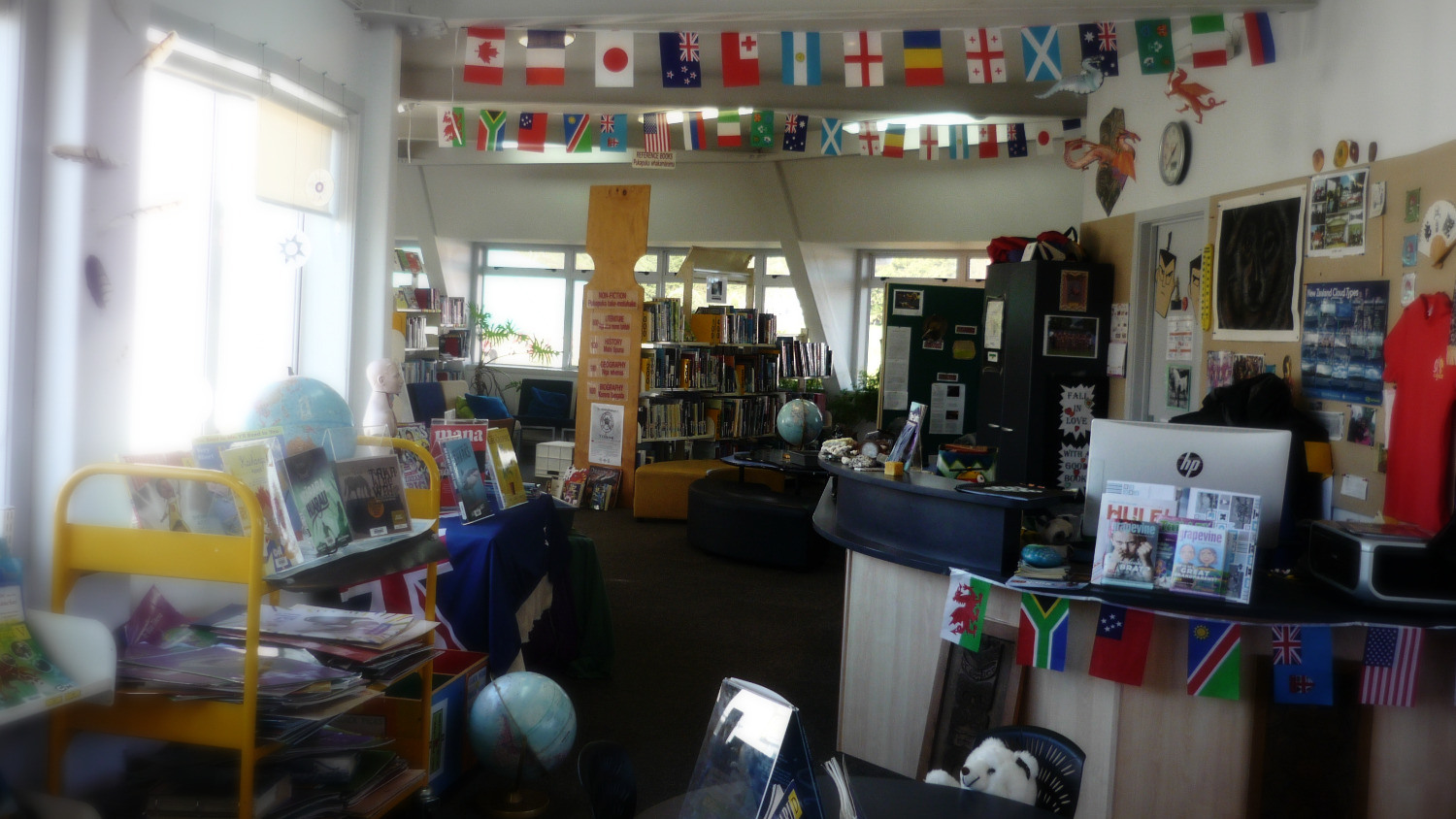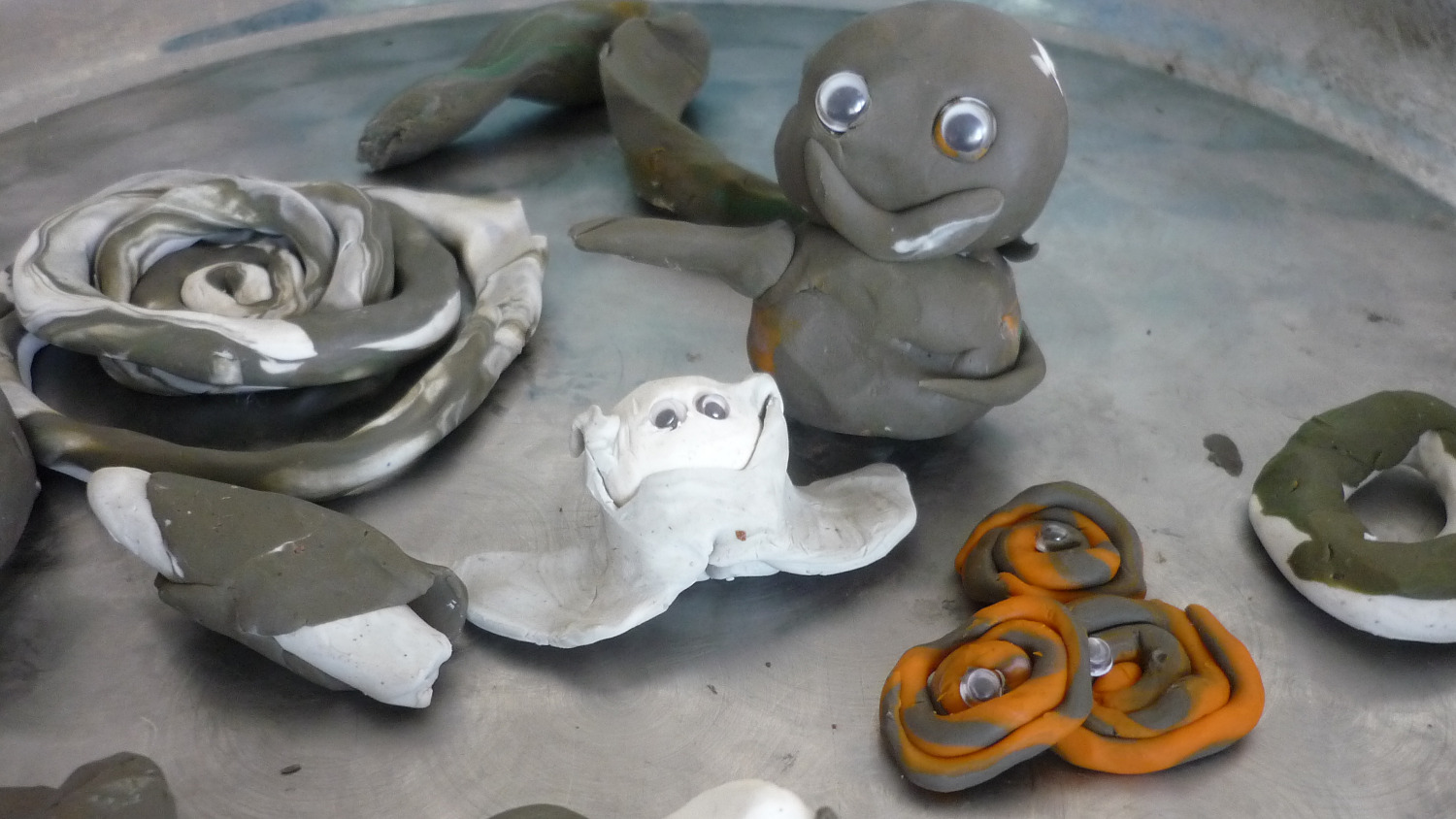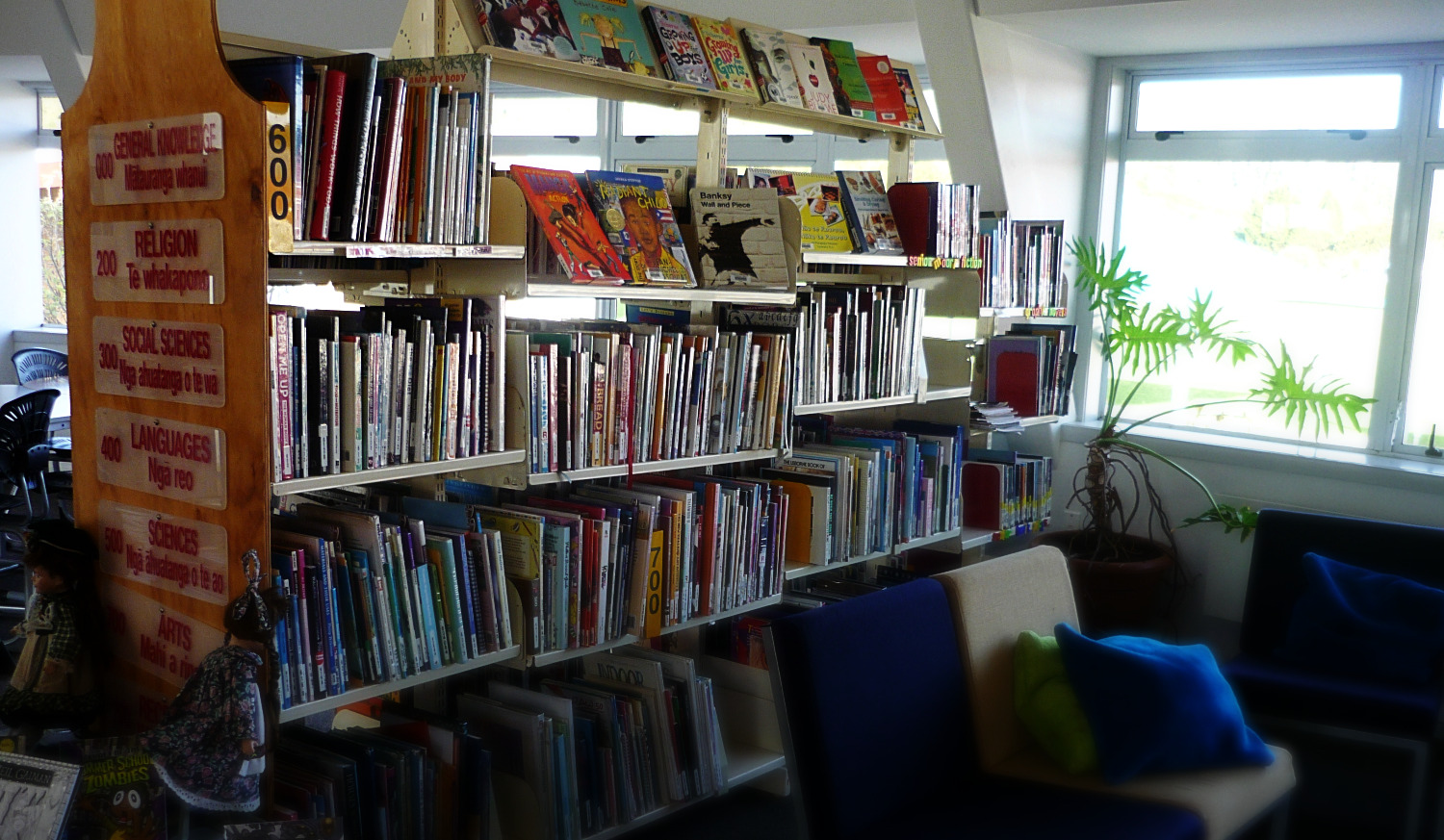New Zealand’s school librarians are passionate, engaged professionals who know how to get students of all ages and reading levels into reading. This, by Adrienne Browne of Te Wharekura o Ruatoki – the longest-running bi-lingual school in New Zealand – is the fifth in this series.
I work in the library at Te Wharekura o Ruatoki, which has around 200 students going from Year 1 – Year 13. I was asked to do this job after doing other bits and pieces around the school and of course, I kept hanging around the library. I’ve been here for twenty years and now I know the children of the children who were here when I came to Ruatoki.

I was here when the armed defenders pointed guns at our nannies and searched the school bus during the Terror Raids of 2007. I witnessed the apology to Tūhoe, a toxic mould outbreak (after heavy rain you could stamp your foot and the carpets would splash), and a big electrical fire that burned down the gym and four classrooms in 2009. Though I wasn’t raised here (my Mum was born here), I am in awe of this tight community where Māori is the first language. Luckily I’m related to most of them!
A community of librarians
I try to attend the once a term SLANZA (School Library Association of New Zealand Aotearoa) school librarian network hui. SLANZA are the unsung heroes of the library world – they advocate for school libraries and provide a real human when asked for help. They produce Collected, an online magazine, loan books, and try their best to upskill us. All for a nominal fee. There’s also invaluable resource, the Schollib ListServ, for everything else.
We all love a good story
Books can let you know you’re not alone. They can educate and they can tell you stories – we all love a good story. At our marae, in the kitchen we’re entertained by pig hunters with genius comic timing and I’ve shared stories with women that started with ‘so why doesn’t my niece just leave him?’ But I digress. And that’s probably my point.
Books can let you know you’re not alone.
Children’s literature has so much competition… ‘screens’ of all sizes verses the lack of books at home and overcrowded households on a budget. To level the playing field, I’m will offer a small reward for kids who choose a number of books they think they can read, write the titles down in a notebook and let me know when they’re done. Their rewards aren’t big: notebooks are popular, or a cheap set of pencils, a special shell with an origami bird made by my son, or perhaps a single semi-precious stone. I have one Year 6 boy who wants a cover-coming–off 2009 Guinness Book of Records for ‘five books’.
I’ve been asked not to let the Year 1-3 students take out library books because they can’t look after them. I have a special painted-up cardboard box with simple Māori journals (mainly) with a number on the front. The Yr 1-3 write their names down in an exercise book – their squiggles are done with such seriousness – alongside the number on the journal. When they return the book they cross off their name and get a new book. Of course that never works. They can’t find them, their baby sister ate it… I think of this as Ruatoki’s “Books in Homes”.

Prisms and Plasticine
Aside from class visits, I have a ‘moko time’ that can look like chaos but a controlled chaos… I use what I know about the students to decide on activities. Before they hit high school they’re interested in EVERYTHING! (After high school they’re mostly interested in each other.)
Before they hit high school they’re interested in EVERYTHING! (After high school they’re mostly interested in each other.)
Apart from the usual jigsaw puzzles and games there are cardboard boxes, a beeping cash register, clipboards for playing shops, CD’s in the windows, which scatter rainbows everywhere. They play with prisms, binoculars, kaleidoscopes, a stethoscope. There’s a bench of semi-precious stones and local rocks (I have 5-year-olds who can identify “amethyst.”) The plasticine is a big hit though not for the faint-hearted supervisor. The library has clipboards, army figures (the girls also use them), puppets, a whiteboard and five darlings talking at once about the books they either wanted to get out and/or why they haven’t returned the other ones.
This is typical except for Tuesdays a.k.a. ‘Rotation Day’. The Years 7-8 move around classes in conveniently small groups. I walk them through basic library skills. Students compete over the joys of the Dewey Decimal system and ‘what would you find in the 500’s?’ Last week they played charades using ‘genre’ terms and characters – I have a great job.

Library lay-out
When you come upstairs to the library, the first books you’ll see are the picture books (facing out). There’s a trolley of ‘Quick Pick’ books for those who want a gentle transition to chapter books. Most of those books are from the Usborne Young Reading series which are hard-covered and introduces some non-fiction titles. I make sure they’re all nicely Durasealed and in good condition to give them that “grown-up” feeling. Some kids will pick from the trolley for a year while building up their reading courage.
In the senior section, I’ve separated out a couple of genres – graphic books (both fiction and non-fiction) and te reo Maori books. The junior Maori language books (tagged with a yellow dot and koru sticker) come from the ‘Koiri’ series of fiction readers and the non-fiction ‘Whakawhiti’ series. The senior Maori section (with koru sticker and red dot) holds everything else.
I have a handful of books that deal with ‘adult themes’ – both fiction and non-fiction. If you can reach that highest shelf, you’re probably old enough to read them.
A time for change
I’d like more books in simple English suitable for students in the third form, learning to read English for the first time (we’re total immersion Maori till then). There are simple books around but most feature little kids – imagine how well this goes down for pig hunting and/or dating high-schoolers.
I proselytise for titles all the time. The Principal has had It’s a book! by Lane Smith foisted upon him because the library enjoys no computers (a school decision) and I can identify with the main character who’s ‘old school’. Recently, I answered a senior’s request for a how-to-draw manga book – but what if I follow it up with a Banksy book for a bit of eye-opening?

Final Word: Can I just do a shout out to all those Trusts and publishers and general good guys who donate books to schools. We thank you and we love you even if we’re tardy about sending thank you notes.
DID YOU LIKE THAT ARTICLE?
Find more of our School Librarians of Aotearoa series here.
Adrienne Browne
1960’s -70’s: I was raised in Gore when all kids rode bicycles, built huts and played around creeks.
[Read PippiLongstocking,LordoftheRingsand every AndrewLang’sFairy Talesin the Gore Library.]
Because I codn’t do maths I disrupted others until the teacher let me read. He introduced me to The Ragged Trousered Philanthropistsby Robert Tressell and Tolstoy (during my Dostoevsky phase).
1975 – early 80’s: Otago University (Post Graduate Dip). Joined ‘Daybreak’ Women’s Bookshop collective, New Zealand’s first women’s bookshop. Started my book buying addiction.
[Read TheWomen’sRoom, Doris Lessing and Margaret Atwood]
1981 – 1994: Anti Tour group, setting up Dunedin Rape Crisis and Te Whare Pounamu Maori Women’s Refuge. [Read Audre Lorde, anything by Barbara Kingsolver, Women who Run with the Wolves, by Clarissa Pinkola Estes]1988 and 1990: Birth of our two sons. Read to them every night till they were 16.[Read Philip Pullman’s Dark Materials trilogy, Maurice Gee, Margaret Mahy. There’s lots of great YA fiction out there]1996: Moved to Ruatoki when Tame Iti asked 'What’s keeping you fellas in Dunedin?'[Read Elsdon Best, Tohungaby Hohepa Kereopa, with Neil Gaiman and Terry Pratchett my ‘go-to’ authors.]



